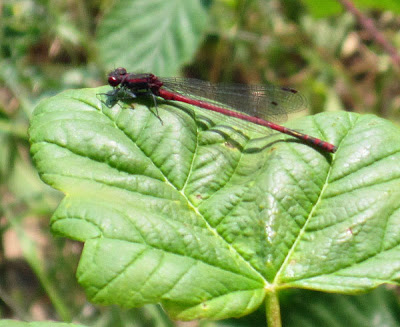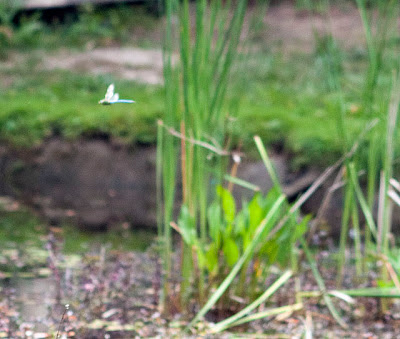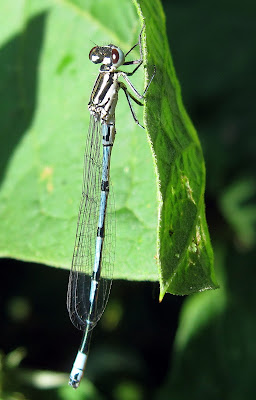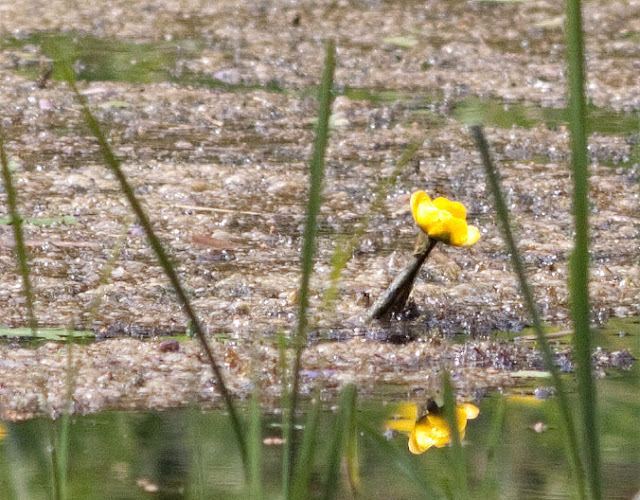 |
| Some of the group examining a hemlock, Conium maculatum. |
There was a lot. We expected the day to be comparatively cool, but in fact it got warmer all through the morning and by the time we left the hot sun was drying us up. Sunshine brings out insects, and High Elms is always full of interesting plants.
We started by wandering up to the ponds by the BEECHE café. The smaller pond was dry, but there was water in the other, and the plant life there didn't seem to have suffered. There were a few blue damselflies, and a white plumed moth appeared too, rather a surprise.
 |
| Large red damselfly, Pyrrhosoma nymphula. High Elms Country Park, 4 June 2011. |
On past the butterbur patch to the arboretum pond. Here there were more blue damselflies. In fact as the day warmed up, the blues made appearances everywhere we went. We also saw some large reds. And there was a big dragonfly circling and swooping around the pond. It was an emperor, though you couldn't tell that from the rather blurred and distant photo I managed to take.
The pond margins were full of greater spearwort, a large relation of the buttercup, with similar (but larger) yellow flowers. The water lilies in the pond looked idyllic; among them was a solitary yellow water lily, also called the brandybottle and said to smell of alcohol, though it was far too far away from us for that to be tested.
Near the pond was an impressively large hemlock, poisonous but with an interesting and rather attractive smell.
 |
| A distant Emperor dragonfly, Anax imperator, zooming round above the pond. High Elms Country Park, 4 June 2011. |
We moved on again towards one of the chalk meadows to see some orchids. On the way we saw another dragonfly moving around the golf club car park, a southern hawker.
Orchids are very interesting plants and make a fascinating study, but sometimes I think too much is made of them. But on the edge of the meadow area we found a patch of common spotted orchids, and they were little beauties.
Some of the group had brought their lunch and went on to a nearby seat. The rest uf us returned. Just before we reached the car park I finally got a good photo of a damselfly. All the others had moved too fast or were too nervous for my little Ixus to capture them.
 |
| Azure damselfly, Coenagrion puella, male, on burdock. High Elms Country Park, 4 June 2011. |
That photo is on the left. The damselfly was resting on a burdock where last week I found an eyed ladybird, so it's definitely worth checking it out before leaving.
It's unusual in that the thorax, and most of the abdomen, are white and black rather than blue and black. The abdomen has a little blue. As with all these photos, you can click on it to see it enlarged.
This brief description misses out encounters with many plants and invertebrates, some of which are pictured below. But it's worth mentioning that we saw many ladybirds, including several seven-spots, but most of them were the invading harlequins.
I have set up a Picasa web album for photos of unidentified plants and creatures, including some from this field trip. You should be able to see it and add comments; please do, if you recognise them! You should also be able to add your own photos. It's here: Unidentified Lifeforms The pictures from this trip are the butterfly; the beetle on the ground; the soldier beetle; and the millipede.
More images ...
 |
| Cone of a douglas fir, Pseudotsuga menzesii, showing the typical shape of the bracts. High Elms Country Park, 4 June 2011. |
 |
| White plume moth, Pterophorus pentadactyla, in temporary captivity. High Elms Country Park, 4 June 2011. |
 |
| Greater spearwort, Ranunculus lingua, round the arboretum pond at High Elms Country Park, 4 June 2011. |
 |
| Yellow water-lily, Nuphar lutea, also called brandybottle, in the arboreum pond. High Elms Country Park, 4 June 2011. |
 |
| Harlequin ladybird, Harmonia axyridis; two different colour forms mating on a comfrey leaf. High Elms Country Park, 4 June 2011. |
 |
| Hoverfly, Xanthogramma pedissequum, on a stinging nettle leaf. High Elms Country Park, 4 June 2011. |
 |
| Common spotted orchid, Dactylorhiza fuchsii, with beetle. High Elms Country Park, 4 June 2011. |
The emperor dragonfly, water lily and greater spearworts were taken with my EOS 450D and a 200mm lens. All the other photos were taken with my Canon Ixus 100.
Wonderful! But I vow, we do not have so many kinds of beetles and things, and we hardly have nettles at all, let alone wild-growing 'common' orchids.
ReplyDeleteYou must take very good care of your Nature.